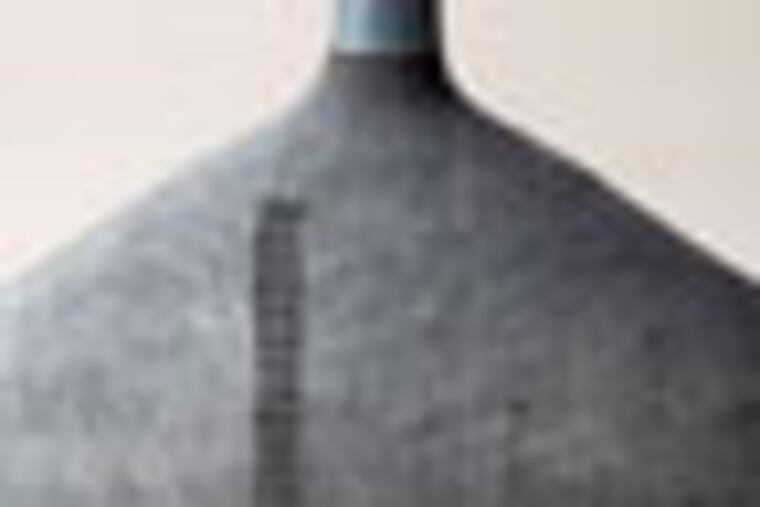Galleries: In prints and paintings, an outlook on devastation
Familiar to Philadelphians from her Print Center solo of 2008 and PAFA's Philagrafika group show of 2010, Orit Hofshi's carved woodblock and painted renderings of desolate, roiling, war-torn landscapes are so visceral that viewers can almost feel the intense energy that propels Hofshi as she works.

Familiar to Philadelphians from her Print Center solo of 2008 and PAFA's Philagrafika group show of 2010, Orit Hofshi's carved woodblock and painted renderings of desolate, roiling, war-torn landscapes are so visceral that viewers can almost feel the intense energy that propels Hofshi as she works.
The sensation of sharing a physical relationship with the art resonates in her current solo exhibition, "Orit Hofshi: Resilience" at Swarthmore's List Gallery, too, but the enormous scale of her work in this modestly sized gallery make the massive woodcuts, prints and paintings appear to be windows looking out to kaleidoscopic scenes of destruction in a country of no particular identity. That is a slightly scary, discombobulating feeling. When you learn that Hofshi's mother was the only Jewish child to escape the Nazi occupation of her town in then-Czechoslovakia (she and Hofshi's father, also a Holocaust survivor, helped found Matsuva, one of Israel's first kibbutzim), you realize that these indeterminate, devastated landscapes are much more literal than they look.
In fact, Hofshi's invented landscapes are largely based on sites in her native Israel, although the ruins in them can suggest landscapes in European countries as well. Occasionally a solitary male figure appears, paused in a moment of reflection or on a mission. In all these landscapes, it's clear that something happened and that the rubble holds the clues.
This is most obvious in the painting Reclaim, which depicts a man in a suit clambering through detritus with an expression of fierce determination on his face. (This also happens to be the one work in the exhibition that makes me think of America, of the images of destruction after Hurricane Katrina, and of the work of William Kentridge, with whom Hofshi has been compared.)
The exhibition marks her first installation, Convergence, which takes up the entire back space of the gallery. (I did not consider her 2010 Philagraphika work, If the Tread is an Echo, to be an installation, though some viewers may have because it could be entered.) Viewed from a wooden observation deck and theatrically lit, the space, which has been painted entirely black, has shallow, rectangular trays filled with inky fluid on its floor. It could be a shoreline as seen at night.
But above the glistening "ink" (it's actually oil), the artist has diagonally suspended four woodcut prints showing scenes of cascading rubble. Further back in the dark recesses, the two woodblocks from which the suspended prints were printed are supported by poles and stand erect like sentinels, as if to prove that history cannot be erased.
Into the light
Charles Ritchie has lightened up since his last show with Gallery Joe.
Rather than concentrating solely on nocturnal scenes of his domestic interior and immediate neighborhood on a cul-de-sac in Silver Springs, Md., as he has for much of his career, he occasionally turns his eye to sunlit subjects, and the results are dazzling.
Never mind that May, a graphite and charcoal drawing Ritchie began in 1996 and finished this year (he has been known to work on a drawing off and on for years) is composed largely of shades of gray. It captures the essence of a warm spring day when every plant and tree has burst to life in the kind of celebratory harmony that Charles Burchfield captured so memorably in color.
A modest neocolonial house that stands across the street from Ritchie's, a nocturnal subject of many years' standing, has emerged from the shadows and appears almost shockingly white in the snow in his watercolor and graphite House: 29 January 2011, 10:30 a.m. (2011). The real shock, I suddenly understand, is that my eye has learned to expect his enveloping, mysterious darkness.
There are also a few new works in dark color - a tree framed by a gray-blue evening sky in November, 1999-2011 (2011), is one - and black-and-white graphite drawings in mid-tones that avoid sharp contrasts of dark and light, such as Graphite Night II (2010-2011).
I'm not won over by color in Ritchie's work - he's made a noteworthy contemporary contribution to the enduring appeal of black and white - but it's fun to see him branching out.
China/Japan
If the exquisitely made object seems in short supply these days, go no farther than the Clay Studio. The eight Japanese ceramists brought together in 5 by 8: New Ceramic Art From Japan know not only the essentials and particulars of dirt, glazes, and firing, but possess marked individual styles.
At first glance, Makoto Saeda's blue-and-white porcelain vases might seem to be the conventional "china" we all know, but the large scale of his pieces and unexpected imagery (fighting guinea hens, for starters) make it clear he is playing on that tradition.
Likewise the work of Kunio Watanabe, whose complex, patterned vase forms appear to have been stenciled but were hand-painted.
The simplest form and subtlest glaze delivers the strongest punch, though, in the small bowls, water pot, and vase by Takashi Tanaka.